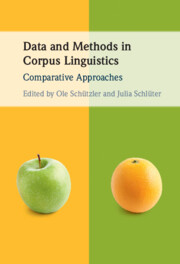Book contents
- Data and Methods in Corpus Linguistics
- Data and Methods in Corpus Linguistics
- Copyright page
- Contents
- Figures
- Tables
- Contributors
- Acknowledgements
- Introduction: Comparative Approaches to Data and Methods in Corpus Linguistics
- Part I Corpus Dimensions and the Viability of Methodological Approaches
- Part II Selection, Calibration and Preparation of Corpus Data
- 3 Comparing Approaches to (Sub-)Register Variation
- 4 Comparing Baselines for Corpus Analysis
- 5 Comparing Study Designs and Down-Sampling Strategies in Corpus Analysis
- Part III Perspectives on Multifactorial Methods
- Part IV Applications of Classification-Based Approaches
- Index
- References
5 - Comparing Study Designs and Down-Sampling Strategies in Corpus Analysis
The Importance of Speaker Metadata in the BNCs of 1994 and 2014
from Part II - Selection, Calibration and Preparation of Corpus Data
Published online by Cambridge University Press: 06 May 2022
- Data and Methods in Corpus Linguistics
- Data and Methods in Corpus Linguistics
- Copyright page
- Contents
- Figures
- Tables
- Contributors
- Acknowledgements
- Introduction: Comparative Approaches to Data and Methods in Corpus Linguistics
- Part I Corpus Dimensions and the Viability of Methodological Approaches
- Part II Selection, Calibration and Preparation of Corpus Data
- 3 Comparing Approaches to (Sub-)Register Variation
- 4 Comparing Baselines for Corpus Analysis
- 5 Comparing Study Designs and Down-Sampling Strategies in Corpus Analysis
- Part III Perspectives on Multifactorial Methods
- Part IV Applications of Classification-Based Approaches
- Index
- References
Summary
This chapter throws into relief the importance of the link between corpus hits and their sources (i.e. texts or speakers) by comparing study designs uninformed and informed by such metadata. The authors’ argument draws attention to the consequences of uneven distributions of observations across the basic text units of a corpus. In the case study (a distributional analysis of the use of actually in the BNCs of 1994 and 2014), it is demonstrated that disproportionate word counts contributed by individual sources (in this case, speakers) will distort estimates for relevant subsections of corpus data (in this case, demographic groups defined by age and gender) if the analysis assigns the same weight to every observation. The proposed solution is to factor in the text (or speaker) level, but this hinges on the availability of the relevant metadata. Moreover, insights into the hierarchical structure of corpus data are shown to benefit the design stage of a study. Thus, if manual post-processing steps preclude an exhaustive analysis of corpus hits, insights into the organization of data points can direct down-sampling strategies to generate a statistically efficient subset of tokens.
Keywords
- Type
- Chapter
- Information
- Data and Methods in Corpus LinguisticsComparative Approaches, pp. 127 - 160Publisher: Cambridge University PressPrint publication year: 2022
References
Further Reading
References
- 2
- Cited by



